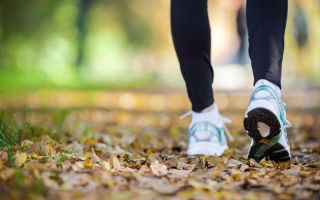Content
- 1 What is the use of walking
- 2 Weight loss benefits of walking
- 3 How many calories are burned when walking
- 4 Which is better for losing weight: walking or running
- 5 Types of walking
- 6 Correct walking technique
- 7 How much to walk
- 8 Where and when is it better to walk
- 9 Clothes and footwear for walking
- 10 How to stay motivated to exercise
- 11 Conclusion
Walking is becoming an increasingly popular form of activity, there are even mobile applications that track the steps of their owner, measuring their daily physical activity. The benefits and harms of walking as the most affordable way of physical activity are discussed by scientists from medicine, its miraculous effect is promoted in the trend of a healthy lifestyle.
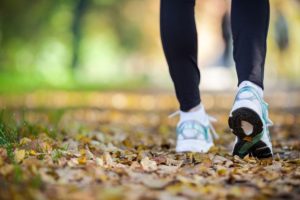
What is the use of walking
The beneficial properties of walking as a type of physical activity, in which all groups of leg muscles, neurophysiological and biomechanical processes are involved, are manifested:
- in strengthening bones, improving water-salt balance;
- regulation of blood pressure;
- lowering cholesterol levels;
- toning muscles and improving sleep quality.
Walking can also lower your risk of cancer and type 2 diabetes.
Maintaining general health
In 2009, a study was conducted in the United States, in which more than 46 thousand people took part. The results are impressive: regular walking has a beneficial effect on risk reduction:
- diseases of the cardiovascular system by 30%;
- early death - by 35%.
Walking provides heart benefits even to those who walk less than 8 km in a week, and walking long distances at an accelerated pace is the most effective protection against illness.
Physical activity
Every step you take while walking helps release energy and boosts mental health hormones. The pulse quickens from 70 to 100 beats per minute, and the flow of blood and oxygen is directed to the muscle fibers. When walking, on average, 5 kcal is burned per minute, and in a sitting position - only 1 kcal. Two hours of walking can easily replace a full cardio workout.

Preservation of youth
Scientists are confident that the beneficial properties of walking can easily slow down the aging process and the occurrence of age-related diseases.
After observing a group of middle-aged people for 9 years, it was proved that whoever devotes to walking for at least 20 minutes a day (about 2.5 hours a week) has a lower rate of UFD 1 proteins, which cause cancer and age-related diseases.
Good mood
Half an hour of daily walking on foot, thanks to the beneficial properties of actively raising mood, increasing energy reserves, will help get rid of accumulated stress: such a result was obtained by a study conducted in 2015 by Canadian scientists. Hiking promotes the production of endorphins and neurotransmitters, preventing depression from occurring.And walking in nature, far from the bustle of the city, is of particular benefit to human health.
Brain function
Another beneficial property of walking, research suggests, is that it can enlarge the hippocampus (the part of the brain responsible for learning and memory), which can improve mental performance. It helps to improve the structure of the cerebral hemispheres, their functioning and strengthen the connections between nerve cells, which has a positive effect on the development of the brain's ability to multitask.
Strengthening bones
Daily walks can help protect against the harms of osteoporosis and arthritis. Moderate stress while walking maintains bone density and, unlike running, is not capable of harming the body. Muscle mass puts pressure on the skeleton, thereby promoting bone regeneration. Moreover, walking keeps the joints flexible and trains the vestibular apparatus. Walking on foot is especially beneficial for the spine: it helps to strengthen it and form the correct posture.
You can find out more information about the benefits and dangers of walking, as well as about its properties and effects on the body, from the video:
For women
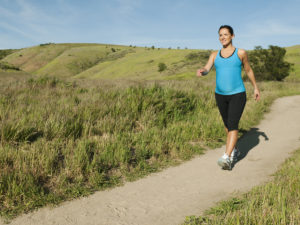
- Active weight loss. Walking, like any other physical activity, helps burn calories efficiently. Instead of storing them as fat stores, the body converts all proteins, fats, and carbohydrates into energy. To increase the effectiveness of walking for weight loss, it is necessary to maintain an appropriate pace: it should be twice the speed of normal walking (within 8-10 km per hour). Then the body will actively seek energy sources and burn fat reserves. Of particular benefit to the female figure is climbing stairs, in which, in addition to burning calories, the active development of muscle fibers is stimulated. Hiking quietly "remodels" the figure, giving the shape of the buttocks, thighs, arms and shoulders smooth outlines.
- Increased muscle tone. Walking stimulates an active heartbeat without stressing the heart muscle. In the course of repeated studies, scientists have found out that walking at a fast pace reduces the risk of heart attack by 50%! In addition, such a load cannot harm sensitive female joints, unlike jogging or exercising in the gym.
- Stimulation of blood circulation. Active walking significantly speeds up blood circulation, helping to strengthen the immune system. This eliminates the harm of free radicals and protects against various kinds of viruses and diseases. In 2011, another study was organized at Boston Medical University: scientists monitored a group of women with breast cancer. The results showed that subjects who spent 4 to 6 hours a week on foot walk quickly recovered.
The benefits of walking on foot to stimulate blood flow are reflected in a woman's appearance: the skin becomes more toned, cellulite, stretch marks and even age wrinkles go away.
For men

- Walking has the beneficial property of working out the cardiovascular, muscular and respiratory systems in the male body.
- Hiking speeds up metabolism and stimulates active fat burning: 15 minutes of walking at an average pace can burn more than 100 kcal. In the process of walking, the main muscles are also worked out: the press, gluteal, quadriceps, and calf. Walking for a few hours at a brisk pace can completely replace an intense workout in the gym.
- The benefits of walking for men are to prevent congestion in the pelvic organs, diseases of the cardiovascular system, supporting apparatus, and diabetes.
- Thanks to the increased work of muscle fibers, blood flow through the veins improves, which serves as a prevention against the harm of the development of varicose veins and helps to get rid of toxins.
- Men are most susceptible to damage to the heart muscle, but the benefits of walking on foot can prevent this: regular walks for 20-30 minutes a day significantly reduce the risk of stroke or heart attack.
For seniors

- Strengthening the cardiovascular system. The benefits of outdoor walks help strengthen the heart, and walking 20 to 30 minutes a day reduces blood pressure and the risk of heart muscle damage.
- Strengthening bones. In old age, human bones become more fragile, so they need to be constantly strengthened with regular exercise. Due to its ability to increase bone strength, walking will be helpful in preventing the development of age-related osteoporosis.
- Stimulation of the brain. The risk of developing Alzheimer's disease or dementia increases with age. Walking, thanks to the beneficial property of saturating the brain with a large amount of oxygen, helps to stimulate its activity. Hiking can speed up the thinking process and improve memory.
- Increased immunity. The body of older people is more susceptible to viral diseases, therefore, in addition to proper nutrition, it is extremely important to monitor its physical activity. The benefits of walking slowly in the fresh air on a regular basis include reducing the chances of catching a cold or flu and even preventing cancer.
- Regulation of blood sugar levels. Walking (especially after lunch) will protect you from developing grade 2 diabetes.
Weight loss benefits of walking
Walking every day at an intense pace has benefits for weight loss: the effect is stronger than a morning run or workout in the gym.
Many people give up jogging in the morning because of the powerful load that not everyone can handle. Brisk walking allows you to cover a distance equal to the jogging distance with the benefit of the figure, without harming the tendons and joints.
What's more, hiking can save you a lot of time and money on fitness. To fulfill them, special conditions are not required: you just need to find the nearest park or stadium and just start walking. And for those who cannot tear themselves away from work, but want to remove extra centimeters, there is another option - walking on the spot. The benefits of walking quickly on the spot are no different from walking at a brisk pace, but it will save some time.
How many calories are burned when walking
Being in a stationary state, the body spends energy only on the processes of its vital activity: the work of organs and muscle tissue. At the same time, only 1 kcal per minute is burned per 1 kg of weight at a minimum heart rate and respiration. As soon as a person starts to move, energy consumption immediately increases by 40%: the body spends resources on pumping blood, maintaining body balance, etc. The pulse and respiration rate increases.
To calculate your number of calories burned during walking, you do not need to use tables: you just need to know your weight, distance traveled - and multiply them among yourself. So, a person weighing 60 kg, having covered a distance of 24 km, will spend 1440 kcal (60 * 24 = 1440). To measure the distance traveled, it is recommended to use a pedometer, which can be easily installed on your phone.
Which is better for losing weight: walking or running
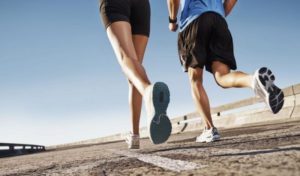
Both running and brisk walking use the same amount of calories. However, these two types of activity differ from each other in properties and beneficial effects:
- Walking primarily strengthens the leg muscles, while running strengthens the pectoral, dorsal, gluteal, and thigh muscles.
- Walking eliminates the "flight phase" inherent in running.Thanks to this, the pressure on the spine and joints is significantly reduced, which will be especially beneficial for people who are overweight.
- Unlike walking on foot, running under excessive stress can cause serious damage to the heart, lungs, spine and the entire musculoskeletal system.
- If the goal of training is not to "dry" the muscles, then it is better to take brisk walking as a basis: unlike running, it does not start the process of burning muscle tissue, and its benefits for the figure and health remain unchanged.
- For the fastest possible weight loss, jogging is suitable: to achieve the same result while walking, you need to spend much more time. The walk should last at least an hour: this will allow you to walk the norm of 10 thousand steps. However, with weights in the hands, the effectiveness of walking training can be enhanced.
- Jogging and walking have different effects on the mental state: the benefits of long walking are in harmonizing thoughts, and jogging is more aimed at releasing accumulated adrenaline.
- In the process of jogging, you need to constantly monitor your heart rate: indicators should not exceed 120 - 135 beats per minute. This is the optimal number for effective fat burning, which practically does not change when walking fast.
Types of walking
In the sports field, there are 6 types of walking. Each of them has its own beneficial properties.
Wellness walking
Such walks are recommended primarily for people belonging to the third medical group (deviations in health, due to which physical activity should be reduced). Healthy daily walking will also benefit the elderly, whose body requires measured exercise.
When walking on foot, it is important not to slouch, try to keep your back straight and your head straight. You need to raise your chin a little, relax your shoulders and slightly strain your stomach. When taking a step, the foot should first be placed on the heel, and then gradually transfer the weight to the toe. Walk - straight, without swaying from side to side.
Sports walking
Walking provides benefits for efficiently burning calories without harming people who are not allowed to exercise. When taking a step, you need to firmly fix the foot on the ground. The raised leg should be kept straight and in no case bend at the knee. In race walking, you must always maintain "contact with the surface": when one leg rises, the other must be firmly pressed to the ground - then the exercise will bring the maximum benefit to the body.
Nordic walking
Nordic walking is walking with special poles that look like ski poles. The beneficial properties of this walk help to effectively fight extra pounds and obesity, improve coordination of movements and form an even posture.
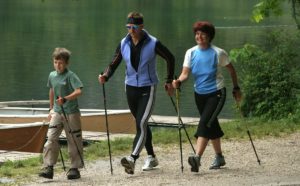
Nordic walking uses more than 90% of the muscles. It is not much different from the usual walking, the difference lies only in the movements: they are more intense, but at the same time smooth and rhythmic. Beginners need to find the optimal pace for themselves that does not cause overwork.
Mastering the "Scandinavian sticks" is not at all difficult. It is necessary to start from a short distance, gradually increasing the intensity and duration of classes.
There is a special Nordic walking technique for beginners. At first, you do not need to rely on the sticks at all: hold your hands, as in normal walking, and then raise them higher and higher until the sticks stand upright.
Walking in place
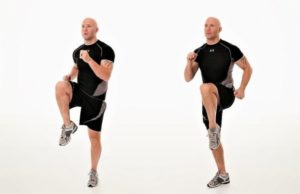
Walking on the spot gives the maximum benefit for working out the main muscles, and also significantly saves time: you do not need to visit the gym to complete it, it is enough to devote 15 to 20 minutes at home. It involves 90% of the muscular system of the body in the work, stimulates blood flow and oxygen supply to the tissues, which significantly accelerates the redox processes.With the intensity of the exercise, the metabolism increases, and all the accumulated toxins are released.
You need to start with a minimum load: 10-15 minutes of walking in place at a moderate pace (60-70 steps per minute), gradually increasing the duration.
Walking on the simulator
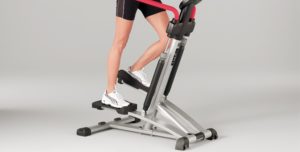
Walking on the treadmill helps you stay in shape without overworking. Such classes have several advantages:
- allow you to adjust the intensity of your workout;
- make it possible to independently adjust the required load parameters: from small to significant;
- this walking option has significant benefits during pregnancy, allowing you to work out the main muscles without pressure on the body of the expectant mother.
Performance:
- Before starting classes, carry out a preliminary warm-up to prepare the muscular system for work. Particular attention should be paid to the most involved areas: ankles, calf, gluteal and femoral muscles.
- It is important to maintain the correct position: the chest is straightened, the back is straightened, and the abs are slightly tense. Bend your arms at the elbows at a right angle.
- Deep breathing, exclusively through the nose. This will help keep oxygen in the blood and stabilize metabolic processes. For rhinitis, inhale through the nose and exhale through the mouth.
Walking stairs or uphill
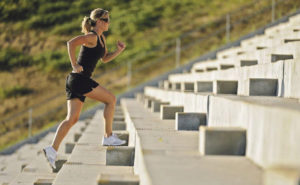
The benefits of walking up the stairs have a positive effect primarily on the joints: the load on them in this case is minimal, and therefore does not cause harm. Its beneficial properties are in activating skeletal muscles, activating metabolic processes and increasing the level of endurance.
First of all, you should abandon the elevator and walk the distance to your floor. Over time, you can begin to train: at a moderate pace, climb to the upper floor of the house, and then descend again to the first. It is better to load the body gradually, giving the body the opportunity to get used to it.
It is necessary to choose the most comfortable clothes and shoes for training: the best option would be a tracksuit and sneakers. As a burden, a backpack is perfect, which will evenly distribute the weight on your back and shoulders.
Walking up the stairs should be done at a measured pace: then training will give the greatest benefit.
Correct walking technique
Before you experience all the useful properties of walking on foot, you should familiarize yourself with the rules that will help to achieve the maximum effect and reduce the risks of possible harm:
- Posture should be in the correct position: keep your back straight without bending or swinging from side to side. Leaning your back to one side will significantly increase the pressure on your spine.
- When walking, the feet are parallel to each other. You should not look at your feet: this increases the risk of curvature of the spinal column. Look straight ahead 4 to 5 meters ahead.
- Keeping the chin parallel to the ground will relieve pressure on the neck and back.
- Do not strain your shoulders, but take them back a little, lower them slightly and relax.
- It is advisable to keep the abdomen pulled in, which contributes to the study of the press.
- If you include your hands in the process of walking, the number of calories burned will increase by 5-10%. Initially, walking with the hands can seem tiring, so in the early stages of training, you can only use them for 5-10 minutes until the body adapts to the load.
- The main rule of effective walking is to transfer the step from heel to toe. That is why it is so important to choose comfortable shoes for training. If, on the other hand, the weight is transferred to the entire foot during the step, this quickly fatigues the muscle fibers and can seriously damage the knee tendons.
- Walking steps that are too long should be avoided, which can cause injury or sprain.
- It is morning walking that brings the greatest benefit: it perfectly warms up muscle tissue and fills the body with energy for the entire next day.
How much to walk
To achieve the most effective training per day, it is optimal to walk at least 10 thousand steps (about 8 km).
There is a scheme for calculating a personal daily training plan:
- 2 thousand steps (1.6 km) allow you to burn 100 kcal.
- For 1 kg of weight, there are about 7 thousand kcal, for the combustion of which you need to take about 140 thousand steps (112 km).
There are several ways to enhance the benefits and effectiveness of daily walking:
- Try not to use vehicles whenever possible. Walking to work in the morning will give you much more energy.
- Eliminate lifts and escalators.
- Catch any opportunity to walk once more: go to the bus stop earlier or take a walk with the dog longer.
Where and when is it better to walk
For walking, it is better to choose open places in the fresh air: parks, squares, and other surroundings. However, in case of bad weather or lack of time, you can try other options:
- a large shopping center or hypermarket;
- schoolyard;
- stadium.
Do not miss the extra opportunity to walk in the fresh air with children: walking on foot will also provide invaluable benefits for a growing body.
Walking in the morning is most effective: it provides active fat burning and benefits in strengthening muscle fibers. An evening walk can awaken your appetite and slow you down.
Many people believe that fasting walking is the most beneficial for weight loss, but nutritionists say the opposite. 30 - 40 minutes before walking, you need to eat tightly: then the body will burn fat both during a walk and after it.
Clothes and footwear for walking
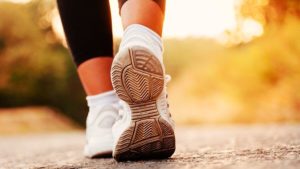
The quality of training and the feeling of comfort will depend on the selection of the form for hiking.
Sneakers are ideal shoes because:
- they are able to endure serious loads and long distances;
- can be ideally matched to the anatomical structure of the foot.
A thick, resilient outsole will help relieve pressure on your foot, which will only enhance the benefits of hiking. The heel of the shoe should be high and stiff enough to stabilize and prevent slipping, and the insoles should be absorbent.
Walking clothing should not be uncomfortable, constricting, or sweating: a tracksuit is the best option.
How to stay motivated to exercise
Sometimes it is very difficult for a person to force himself to get off the couch and walk to the store a step away from home, let alone 10 thousand steps. There are several helpful methods to help you increase your motivation for walking:
- ask a friend to join;
- walk with your dog as often as possible;
- arrange regular evening outings with family or friends;
- calculate the amount saved when walking to and from work;
- start a glider and record in it the daily distance traveled and the number of calories burned;
- explore new areas every day while walking;
- try yourself in hiking.
Conclusion
The benefits and harms of walking continue to be actively studied. However, many useful properties of hiking have already been discovered: maintaining muscle tone, preventing diseases, losing weight and even prolonging youth. Before walking, it is important to familiarize yourself with the rules that will help increase the effectiveness of your workouts and prevent possible damage to joints and tendons.

